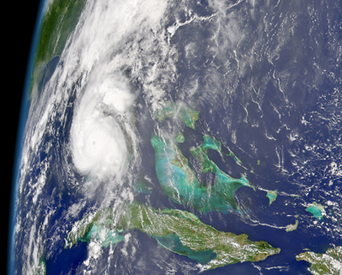 As coastal residents are geared up
for this year’s peak Atlantic hurricane season — mid-August through
October — scientists are looking at past hurricanes to better understand
what happens to the oceans in the wake of these whirlwind events. They are finding
that the storms actually help to fertilize the waters left in their wake, potentially
affecting the global carbon cycle and climate change.
As coastal residents are geared up
for this year’s peak Atlantic hurricane season — mid-August through
October — scientists are looking at past hurricanes to better understand
what happens to the oceans in the wake of these whirlwind events. They are finding
that the storms actually help to fertilize the waters left in their wake, potentially
affecting the global carbon cycle and climate change. Satellite images like this one, taken of Hurricane Charley on Aug. 13, show subtle changes in ocean color in the wake of hurricanes due to phytoplankton blooms. Hurricanes stir up nutrients from the bottom of the ocean. Image courtesy of NASA/Orbimage.
The intense winds from hurricanes blowing across the sea surface stir up deep, nutrient-rich water, allowing phytoplankton populations to surge, according to a recent study. Normally, parts of the ocean are like a desert for these microscopic plants, says Steven Babin, an atmospheric scientist at the Johns Hopkins University Applied Physics Laboratory in Maryland and lead author of the study, which appeared in the Journal of Geophysical Research — Oceans last spring. “Some phytoplankton are always there; there is just little to make them grow” without nutrients from hurricanes, Babin says.
Satellites are giving researchers a whole new view of phytoplankton. Chlorophyll, the green pigment in plants, is an indicator of phytoplankton and can subtly affect the color of the ocean, which satellites are able to measure. Previously, scientists had only been able to take point-samples of chlorophyll from ships. “The investment made years ago is now finally paying off with the satellites,” says Marlon Lewis, a biological oceanographer at Dalhousie University in Nova Scotia. “It is a little difficult to take those measurements by boat in a hurricane.”
Babin’s team used satellite data collected as part of NASA’s Earth Science Enterprise to measure chlorophyll. In examining 13 hurricanes from 1998 to 2001, they found that high levels of chlorophyll immediately followed hurricane events. The researchers considered that the high chlorophyll levels might only be disassociated chlorophyll, stirred up by the hurricane, but the blooms lasted for too long. “If it was just chlorophyll, it should disperse rather quickly, like throwing flour into the air, but the effects lasted for weeks,” Babin says.
The exact duration of a phytoplankton bloom appears to be linked to the size of the hurricane. “With slow-moving, very large, very intense hurricanes, larger blooms are more likely to occur. If the hurricane is too small, it is possible that blooms may not form at all,” says Tommy Dickey, an oceanographer at the University of California, Santa Barbara, Ocean Physics Laboratory and co-author of the paper.
Phytoplankton blooms related to hurricanes may have important implications in the carbon cycle. Phytoplankton, like all plants, absorb carbon dioxide from the atmosphere and “act as a sink for carbon as the planktonic materials sink to the ocean bottom,” Dickey says. Determining the exact sources and sinks of carbon dioxide is vital to understanding possible climate change. Large blooms of phytoplankton following hurricanes may lead to the removal of excess carbon dioxide out of the atmosphere, potentially slowing global warming. But “there are other factors at work too,” Babin says. “It would be nice if we had a net loss of carbon in the atmosphere, but we have not looked at the numbers yet.”
If scientists can prove hurricane-induced phytoplankton blooms reduce carbon dioxide levels, it would help explain discrepancies in the amount of carbon entering the oceans, Lewis says. “We don’t have all the sources for total carbon absorption by the sea figured out. We are missing something out there — it might be the hurricanes … or some other ephemeral event,” he explains.
In the meantime, the National Oceanic and Atmospheric Administration has predicted an unusually active hurricane season for this year, which lasts until Nov. 30. During that time, six to eight hurricanes are expected to materialize with up to four of those reaching Category-3 status. Already, Hurricane Charley made landfall in Florida in mid-August as a Category-4 storm.

